Panama Canal Transit - What happened

Salamander
Sun 2 May 2010 17:38
|
The first choice was whether or not to use an
agent. Of four boats polled everyone that used an agent had the Admeasurer out
within 24 hours. One boat phoned their agent half an hour after Murray attended
the office and was measured the same afternoon. By not using an agent you do not
get a guaranteed appointment date, but you still have to stay waiting on the
boat. They do not let you know in advance if they're not going to attend and
when you phone the offiec they will just say they were too busy to come. We were
bounced our first appointment date and the following daye were back to waiting
between 08.30 - 13.00. The office said the admeasurer had left at 09.30, but he
didn't turn up until 11.45. We had found on another boat at 10.00 and he said he
would be an hour but still didn't turn up for another 2 hours.
We checked with the boat he had gone to before us
and they had booked after we did, but via an agent.
We are here at a quiet time, so do not know if you
get bumped off the list time and time again as new people arrive and appoint an
agent. So the first advantage is that the Admeasurer's office will give
appointments to boats that use an agent within 24 hours.
The other thing an agent does for you is arranging
the appointment in the first place. If you are doing this yourself you are not
allowed to make it by telephone, even though their own paperwork says to phone -
you have to go to their office. Shelter Bay Marina runs a great bus service and
the driver will drop you at the main Port entrance. You then check in with
security, walk all the way to the end with the sea on your right and the pile of
containers on your left. The control tower is surrounded by chain link fence and
you have to wedge yourself through the locked vehicle gates. Then you have to go
to the centre of the building (like a garage), round to the left is a lift and
stairs and you go up to the first floor. Then the Admeasurer's office has a big
sign on the door.
You need your boat papers, crew list (passport
details) boat papers and current clearance, the same as for a normal clearance
procedure. They also ask you your boat speed and Canal Authority speak for 6
knots is Ocho!
The buffer payment of $891 for <50foot boats is
not payable if you use an agent (again checked with a number of boats). Ropes
and tyre fenders are easily hired from an agent and delivered promptly on the
day of your choice at $15 per line and $3 per fender. These are meant to be
available for the Admeasurer, but they aren't checked.
You then need to find line-handlers and yachts
normally help each other. Shelter Bay Marina has a notice board for this and you
need to ask around. Professional line-handlers can easily be hired from an agent
and prices vary from £30 to £75 per day per handler. We have been unable to find
any boat in either direction who did the transit in less than 2 days. The only
things the Admeasurer really checked was the lenght under 50 ft, the presence of
a fog horn (not tested) and the presence of a toilet seat! He then gave us a
form stating the boat may not be up to standard. As far as we could tell,
everyone gets this disclaimer form.
After all this Murray bumped into an agent and
hired the line-handler on the spot, with the agent agreeing to make the transit
schedule phone call. Individuals have to wait until 6.00pm to make the call, but
the agent had the confirmation earlier, indicating agents get first choice of
slots too.
We had hoped for a transit on the Monday, but ended
up with a Thursday evening slot.
Our line-handler - Javier - arrived at mid-day and
we left the Marina at 15.00 as although our transit time was 17.30 he advised
they can turn up early. We both felt confident and happy with our line-handler
from the start. Our Advisor turned up eventually at 18.15 and we were to be
rafted up to a Cat (who stole our fuel slot, but that's another story)By 20.10
we were in the Gatun lock, being towed by the Cat as the bigger boat is always
given control. The Cat skipper was doing the maneuvering and he was a bit all
over the place. Once we were secured by ropes he was obviously very stressed as
he checked the spring lines about 6 times, undoing them and redoing them to
exactly the same place. The first three locks at Gatun take us up an incredible
84 feet. It is very strangfe to be able to look down on where we were less than
an hour ago. We are now off to tthe lake for an overnight stay on a buoy.
Caroline has to cook a meal for 6 and the adviser wants his quickly as he will
shortly be picked up by the tug. As always on any voyage Caz has prepared the
first meal before departing so by 21.30 we are all eating.
We had a poor nights sleep, to be woken at 04.30 by
the howler monkeys. Everyone on our boat was up at 05.00 as the advisors
regularly arrive earlier than the planned 06.30-07.00. Our advisor was no
exception, arriving at 05.45. None of the Cat crew were up and we had to bang on
their boat to get them to wake up. The lady owner got up, came on deck and
scowled at us all. Once we pointed out their advisor had arrived their was a
massive panic on their boat getting everyone up. Caz did the first bit of
helming while Murray cooked breakfast. We did 4.5 knots as requested by the
advisor who then said we could put up a sail to get another 0.5 knots. Caz
explained that this wouldn't work, as we were heading into wind, but that our
engine was capable of doing this. We trhen did 6 knots to the next lock to the
delight of our advisor who hadn't realised we could achieve this speed. The
advisors are pleased when any yacht can do 5-6 knots. It is only if you do less
than 4 knots that you will be turned back.
The rafting to the Cat was done under way and the
Cat skipper obviously had no experience of this as both times he turned left
away from us. The second time he was in danger of turning both boats right round
with only one rope attached. Murray had to get his advisor to stop him from
turning. Then we were down, through one lock and still rafted to the final two
locks at Miraflores where there was just our two boats with an audience of
tourists and the web-cam. It was all over by mid-day with the advisor picked up
at 5 knots and the line-handlers, lines and tyres dropped off at Balboa Yacht
Club pontoon.
It's all downhill from here!
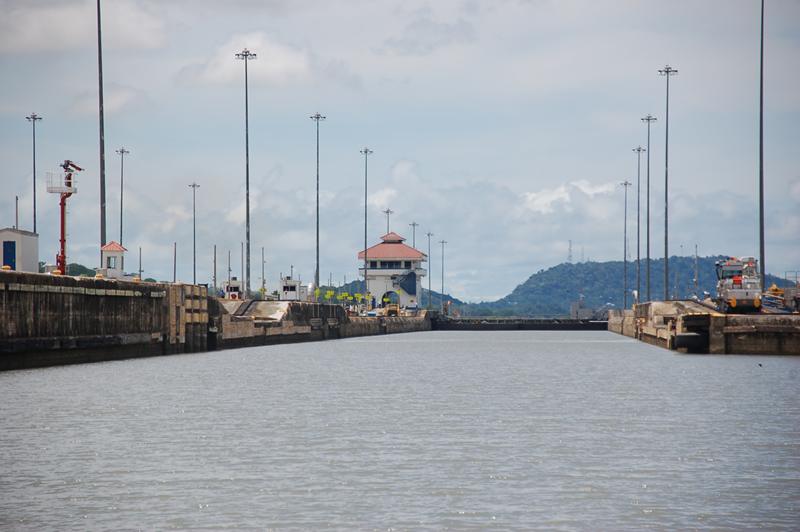 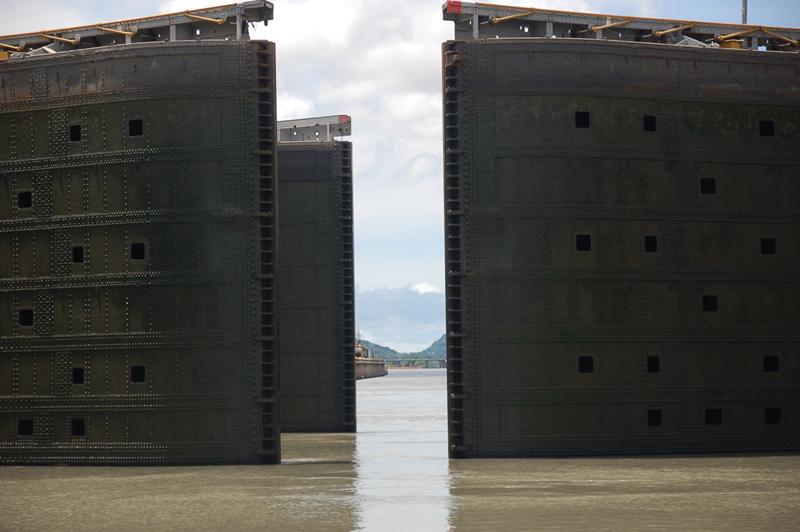 Out into the Pacific Ocean
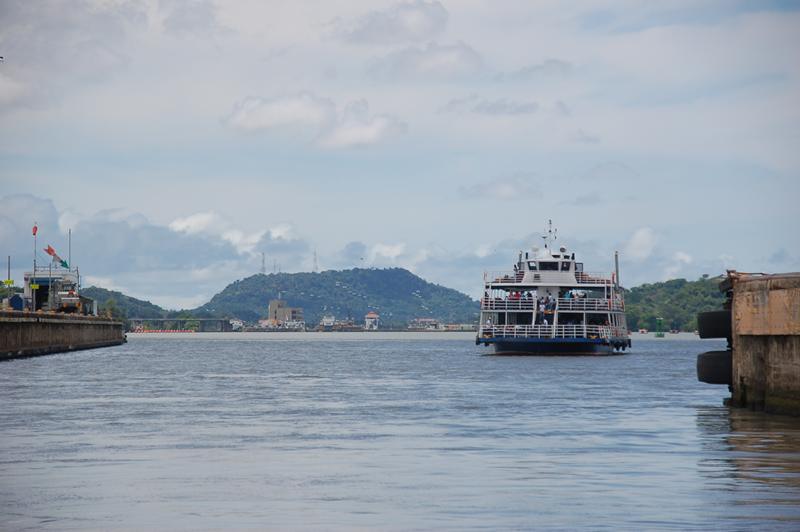 The professional line-handler made all our radio
calls, showed the other line-handlers what to do, controlled one line and caught
the monkeys fist for the aft line, as well as taking our rubbish and sorting out
the lines and tyre-fenders at the end. He was worth every penny and the tip
elicited a grateful bear-hug in return.
 There were no real problems, though our boat was a
bit overloaded and felt very empty when we went from 6 people to 2. The Monkey's
Fists really whizz over the boat, but once attached you just gently motor into
position with the canal line handlers walking the ropes down into the lock. The
advisors talk through every step for everyone and we found both of ours to be
very professional.
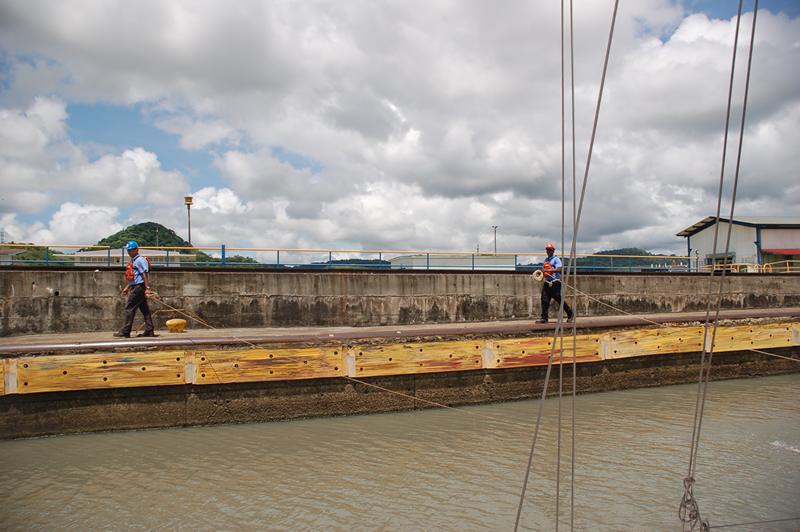 Your boat does not have to be able to do 8 knots,
they are perfectly happy with 5-6 knots and everyone gets the form stating their
boat might not be suitable for the transit. The only part we can't confirm is
whether there is an additional fee (as Murray was told in the Admeasurer's
Office) if you declare less than 8 knots to the Admeasurer. (Mainly because
no-one risked doing so - it's reported to be $800).
Addendum: We have now spoken with a boat who
declared 6 knots and they DID NOT have to pay any additional fee.
The Panama Canal is a magnificent piece of
engineering that has worked continuously since 1914. Now they are building
another set of locks to take the supersize cargo vessels as at 1150 feet long
the current chambers are too small.
Mule (electric train for towing ships through the
lock)
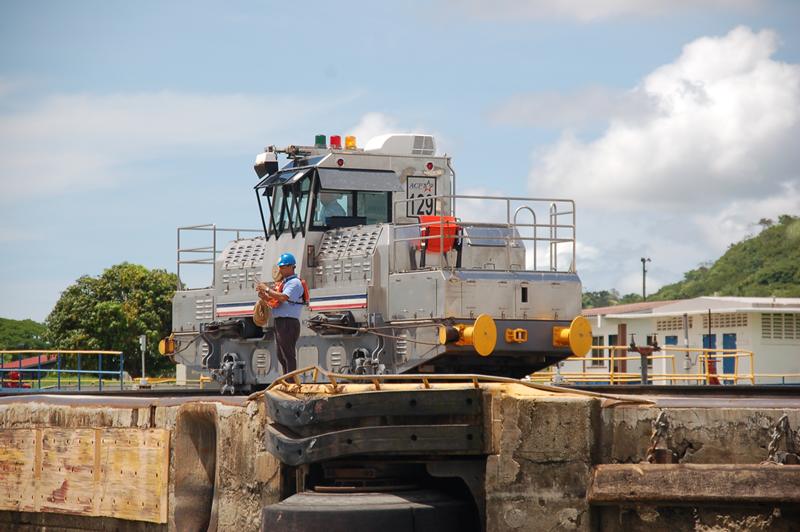 |